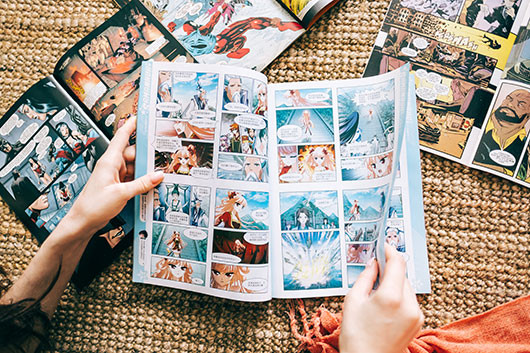How to Publish Your Own Graphic Novel
March 7, 2022
Completing a graphic novel is a huge accomplishment, but now the next step is to get it in front of audiences. Connecting with readers interested in your genre seems easy at first, but in reality, printing and promoting your graphic novel or comic book as an independent author can be complex.
Working with a traditional publisher has its benefits, but self-publishing may give you a better result in the end. Explore the differences between working with a traditional publisher versus releasing a self-published book. Also, learn how to publish your own graphic novel so you can maintain creative control and earn higher royalties on your project.
Traditional Publishing Process
In the past, the only way to publish a successful graphic novel or non-fiction book was to work with a traditional publisher. The publishing process with a traditional publishing company follows a predictable format that includes finding an agent, submitting your manuscript for approval, and waiting on the publishing company’s timeline for the final release.
If you choose to work with a big publishing house, your first step is to write a query letter along with a book proposal to potential agents. If your letter catches an agent’s attention, they may ask for a book description and a few sample chapters before they choose to work with you.
Your agent then shops your book proposal around until they find a publisher. The publisher may offer you a book contract that gives them creative control over the project. It also sets your royalty amount, which typically falls at 30% for a hardcover, 15% for a paperback, and 25% for a digital book. The contract may also offer an advance on sales of your book. However, be aware that if your book doesn’t make back your advance, you owe your publisher the difference.
Once you submit your finished graphic novel manuscript, your publisher may suggest changes and hire a book editor to look over your work. After these changes are made, the traditional publishing house begins designing your cover. Finally, they print your graphic novel and begin book promotions to increase sales.
Pros and Cons of Traditional Publishing Industry
Traditional publishing carries both pros and cons for authors. The pros of working with a big publisher include:
- Upfront advance
- Wide promotional reach
- An existing audience for your niche
- Access to a team of publishing experts
- Changes to your book can make it more marketable
Although a book deal with a big publisher may feel exciting, there are many downsides. Traditional publishing may not be the best choice because of the following aspects:
- Low royalty rates on book sales
- Strict book contract terms
- Loss of creative control
- Harsh editing process that takes away from your original work
- Must pay back the difference if your book sales don’t reach your advance amount
- Long timeline for publishing - sometimes it takes a year or more to complete
An Overview of Self-Publishing
Until recently, traditional book publishing companies have been the only way to get your graphic novel out to a broad audience. Major comic publishers had significantly more marketing power and relationships with bookstores, making it easier for authors to gain royalties for their hard work.
However, social media’s power has made it possible for authors to reach wider audiences and self-publish graphic novels in the internet age. Instead of relying on literary agents, query letters, and submission guidelines, writers and artists can simply publish the story they want without editorial changes from a comic book publisher.
Self-published authors are seeing more success than ever using programs like Kindle Direct Publishing (KPD). KPD allows indie authors to publish books on their own that are automatically available to KDP Select participants.
Authors who self-publish on Amazon and reach out to potential readers through the KDP Select program can earn up to 70% royalties on their book sales. In 2018, Amazon paid $220 million in royalties to self-published authors, showcasing the power of author platforms like Kindle Direct Publishing paired with reader programs like KDP Select.
Pros and Cons of Self Publishing
The self-publishing industry is growing rapidly and is advancing the power of independent authors. Additional benefits of self-publishing include:
- Complete creative freedom
- Work on your timeline
- Hire someone you want to edit, design, and print the book
- Market the book yourself using organic interest or your existing fanbase
- You control every aspect of your book, including the story, format, and appearance
- Earn more royalties from your book sales
Despite these benefits, there are a few downsides to self-publishing as well. These include:
- Slower book sales unless you already have a following
- Need upfront funds to pay for printing and marketing
- No experts to guide you through the process; more of a learn-as-you-go experience

How to Self-Publish Your Graphic Novel
If you are interested in self-publishing your graphic novel to retain creative control and earn better royalties, it’s helpful to understand the process. Here are five general steps to self-publish your own graphic novel or comic book.
1. Complete your manuscript
Finishing your manuscript is a top priority when self-publishing. Unlike in traditional publishing, you can’t start any part of the self-publishing process without having a completed manuscript to work with. If you haven’t started (or finished) your graphic novel, focus on your creative writing and illustration skills and push yourself to complete the draft.
As you near the completion of your manuscript, you will also want to work with a book designer to decide on the layout of the frames and panels. They can help you format your project correctly so that when you go to print, the document is ready for upload. A book designer can also help you design an eye-catching cover that proudly displays your book title.
2. Get it to an editor
A standard part of the professional writing process is hiring an editor to look over your work. Professional editing is necessary to self-publish. Although you may proofread your work, it is crucial to work with a professional editor who can catch spelling or grammar mistakes. They can also point out areas that may need work due to the writing style, tone, or vocabulary.
The best part about hiring your editor is that you gain feedback without the pressure to change anything. You can choose to change what makes sense and move forward with printing.
3. Choose a printer
Once you have a completed, edited manuscript, consider which printer you want to use. Like graphic novels or comics, print books require a printer experienced in this genre. Choose a printer like Comix Well Spring, which specializes in printing comics, picture books, and graphic novels and offers square binding with the number of pages you need. Text-only publishers may not have the same print quality or require large margins in your books.
If you are working around a deadline, choose a printer with a quick turnaround time on delivery. Comix Well Spring offers a 14-day standard production turnaround, with standard shipping taking around a week. We also offer rush production if you need your final graphic novel in time for a convention or other marketing opportunity.
4. Choose your print specifications
When working with your chosen printing company for self-publishing, select your print specifications carefully. Print specifications include size and color.
Graphic novels are often printed the same size as comic books, with 6.625” x 10.25” as the standard option. However, manga size (5.5” x 7.75”) is also a viable option for artists whose work is less detailed, and this size is slightly less expensive than the standard size.
Printing at magazine size is uncommon, but it is possible for graphic novels with a heavy emphasis on detailed art. It’s an excellent way to make your book cover stand out on indie bookstore shelves. Either way, always decide your trim sizes before starting the artwork for a graphic novel, as the print size impacts your ability to fit legible text into speech bubbles.
When selecting black and white or color print options, keep your reader’s expectations and budget in mind. If you have an existing fan base, it may even help to virtually poll them on whether they would pay a little more for a full-color run. Sci-fi and fantasy comic fans typically expect color runs, but this expectation is usually more flexible with longer graphic novels.
5. Market your graphic novel
Marketing your graphic novel is an essential part of the self-publishing process. Unless you already have a devoted following, you’ll need to get the word out about your graphic novel to grow reader interest and start seeing sales.
Social media is the best way to get the word out about your work. Even before you've published your first volume, get on Twitter and Facebook, and begin building genuine connections with other comic fans. Some authors also set up a website and collect fans' email addresses to send updates periodically.
If you live anywhere near a mid-size or larger city, you’ll have easy access to at least a few comic conventions every year. These events almost always have an area for independent comic book and graphic novel creators, and renting a table is easy and inexpensive. It's also a good idea to get retractable banners and tablecloths to help make you more visible at these events.
You might also consider offering a select number of readers a free copy of your graphic novel in exchange for honest book reviews. This is an excellent way to get feedback about your graphic novel and get people talking about it.
Planning for the Future as a Self-Published Author
Although most authors and artists tend to plan multi-volume series, some reach the end of their short story and suddenly realize they want to make a continuation. With indie publications, the good news is that expanding your work is easy and not subject to any external control. You can write a comic that’s as short or as long as you like and even create spin-offs.
Every time you release a new graphic novel, try to promote your other published work as well. This keeps fans engaged between new volumes, and you eventually build a loyal fan base. You can also include pre-order freebies and giveaways like bookmarks and character art to generate buzz.
Self-Publish With Comix Well Spring
Comix Well Spring is an imprint of Greko Printing, a full-service printer run by printing industry veterans. Our services include saddle-stitch binding and square-bound comics and graphic novels, plus a vast range of other items like banners, flyers, business cards, and more.
We know comics, and we’re happy to answer any questions you have about the indie publishing process and how to make your graphic novel a reality. Please contact our customer service team to learn more about our fast turnaround options, commitment to quality and suggestions on how to sell your indie comics.

